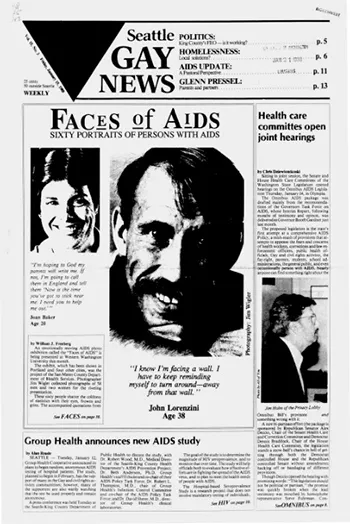
SEATTLE GAY NEWS
VOLUME 15, ISSUE 3
JANUARY 15, 1988
Dive into the archives of the SGN at https://issuu.com/sgn.org
An emotionally moving AIDS photo exhibition called the "Faces of AIDS" is being presented at Western Washington University this month.
The exhibit, which has been shown in Portland and four other cities, was the project of the San Mateo County Department of Health Services. Photographer Jim Wigler collected photographs of 58 men and two women for the riveting presentation.
These sixty people shatter the coldness of statistics with their eyes, frowns and grins. The accompanied quotations from each individual drives home the pain, the fear and hope in the face of an epidemic.
Since the exhibit was first presented, four of the subjects have died. Each of their portraits is marked with a small black flag. Their deaths are also echoed in some quotations by other people, which makes this simple show a serious statement about death and dying.
One man, John Lorenzini, is featured in the promotional posters for the exhibit and raises the fears of death in his quotation. "I know I am facing a wall," he states. "I have to keep reminding myself to turn around away from that wall."
One of the two women, Meredith Miller, has freckles, dark hair and eyes, and a stark frown or grimace. "I've done many interviews," she states, "and in each of them I've publicly thanked the Gay community for their support for reacting to stigma, hate, and fear with love, with compassion, and with education. And not once has the media printed my thanks. If not for the support mostly of Gay men, I would have been dead a long time ago."
Contrasting Miller is Ted Parry, 41. Parry is clean-shaven, except for a moustache that plays with his impish grin. He states, optimistically, "Life is like a movie, you enter in the middle and go out in the middle. There's no beginning – no end."
There is only one – Tedd Hathaway – who doesn't look directly into the camera lens and this is perhaps the most staggering and reflective shot of the entire show. His gaze is cast left and downward. His expression is bittersweet – somber, but in the same moment he seems at peace, relieved; near tears, and the wrinkles outlining his eyes lend him a gentle wisdom. Hathaway's reflective mood is accented even more by his statement. "The mass consciousness of the world today is of love and healing and it's growing by leaps and bounds. This is only the beginning of our lesson that all disease is a healing in progress.
Looking face to face with these people is an overwhelming, heartfelt experience. For those who needed the closeness of people to understand AIDS, they will be educated by the soul reaching statements of these brave people.
This exhibit serves as a living memorial for everyone. We can learn from it, which makes "Faces Of AIDS" the most poignant photo exhibit one may ever see. (These photographs recall the Newsweek spread of last summer that printed many photos of those who died during the year from AIDS.)
"Faces Of AIDS" is showing in Western Washington University's Viking Union Gallery in Bellingham from January 7 to 26. This exhibit will travel next to Washington, DC, and then may go to Stockholm, Sweden. "Faces Of AIDS" may not return to this region soon, and it is worth the trip to Bellingham to spend an hour embracing this wonderful show.
This article was edited for length. To view the original article in full, visit Washington Digital Newspapers

